This document contains the first leg of our return trip from the Black Sea. The leg is from Istanbul to the Greek island of Limnos with stops at Erdek, Çanakkale (visit to Troy), and to the Turkish island of Imvros (Gökçeada). It is illustrated with maps and photographs, and also includes some historical and geographical descriptions of the places visited as well as several links to other related web sites.
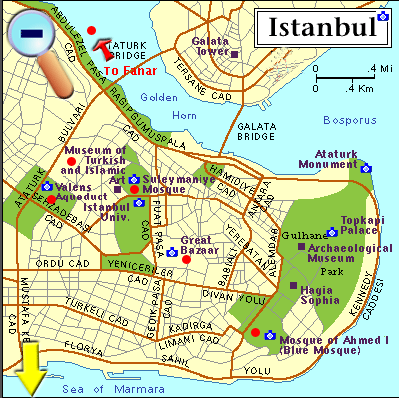
- Zoom-Out
- Grand Bazaar
- Blue Mosque
- Islamic Museum
- Süleymaniye Cami
- Fanar district
- Yerebatan Saray
- Next Map
Click on a location left of a Red Dot to read about it, or on the magnifying glass to zoom-out
We returned to Istanbul from our trip to the Black Sea in time to link up with Andonis’ wife Jane and my daughter Corinna who joined us for the return trip back to Greece.
Jane Ephremides was born in Hawaii of Japanese parents. She is an administrator in the Enviromental Protection Agency and lives in Washington D.C. area, where she met Andonis.
Corinna is a senior at Brown University, where she is majoring in Environmental Science.
Friday August 13, 1999, Day 32
The day did not start very well. While in the cockpit, drinking my morning coffee, a bee stung me. From that start everything was an improvement. When Andonis got up and had his coffee, we hosed the boat and washed her with brushes and detergent.
I then called Mrs. Zuhal Atasoy, the journalist friend of Turgut who had contacted me while we were in the Black Sea. I did not find her but I left a voice message. I then called Turgut on his GSM phone to see what he was doing. He and his family were with the S/Y New Life in the Greek island of Patmos. I like this symmetry; my Turkish friend is sailing in Greece, while I am sailing in Turkey.
Before leaving the boat Andonis and I collected all the dirty laundry. Our intention was to take it to the hotel but on the way out of the marina we checked at the office. They are now more organized than during our inbound trip. They now have an arrangement with a local cleaner. We left the laundry at the office with assurances that this time it would be picked up and that it would be ready tomorrow. We also needed to make an amendment in the transit-log to reflect the addition of Jane and Corinna to our crew. This time we did not even bother to ask at the marina office. We took the familiar dolmus to the Kadaköy ferry dock, and then the ferryboat to Karaköy. At the ferry dock, I used the ATM machine to draw some more money as I was running low on TL. We then walked to the Harbor Master’s office, where the local “admiral” stamped and signed our amended transit-log without any fuss.
It was going to be another hot and humid day. Andonis found a bank to cash a travelers’ check. This, even in Istanbul, took a considerable amount of time. I really cannot comprehend why it is so difficult to cash a travelers’ check in a country that otherwise seems to be doing many things right to attract tourism. After the bank, we walked up the hill to the Celal Sultan Hotel where we were greeted very warmly. No problem with the reservations for tomorrow, and yes they were all prepared to meet Corinna’s and Jane’s planes.
Andonis had not been to the Grand Bazaar in any of his previous visits to Istanbul, so, we walked there and wandered in the myriad nooks and crannies. It is a fascinating place, but the day was extremely hot, to the point that walking was getting to be painful. We sat at a small restaurant within the Bazaar and had a snack with a cold beer. This helped. We then walked to the Spice Market where we bought some lukum (Turkish delight), saffron, and other goodies. It was my turn now. I had never been to the Taksim district. So, we took a taxi there and walked for a while until once again were exhausted by the heat. We sat at a fancy pastry shop and had an ice-cream. After this refreshment, we walked down the hill, through some very interesting neighborhoods, back to Karaköy and the ferry.
While we were on the ferry, Zuhal called me. She wants to visit Thetis, together with a photographer, and interview me. We agreed to meet in the Kalamis Marina on Sunday afternoon at 1:00.
After we got back on Thetis we took showers and relaxed, reading in the cockpit. In the late evening, we took a taxi for the Garaj restaurant at Tarabaya. This is a Greek-owned restaurant, specializing in seafood. It was very strongly recommended by my brother Nikos as a “do not miss” place. The taxi drive took over an hour crawling in the heavy traffic. We both wondered if the restaurant was actually worth this expenditure of time and money, but at last we arrived. The Maitre’d did speak Greek but was not Greek. He did not let us order but made the arrangements himself. We should not have let him do so. There was way too much food. The appetizers were very good indeed, but the small barbounia (red mullets) were mediocre. The total bill was 30 million TL, clearly not worth it. The taxi ride back to the marina was nowhere as bad, it only took 30 minutes.
Aboard Thetis it was hot and there were mosquitoes. The barometer had dropped appreciably to 1001 mB while the relative humidity was up to 81%. Not a very comfortable night.
Saturday August 14, 1999, Day 33
This is the day that we are expecting the arrival of Jane and Corinna. A heavy rain downpour woke us up in the morning. We spent some time cleaning inside the cabin so that Thetis would be shipshape to receive our new guests. The rain had stopped and the day was clearing.
After the cleaning chores, we followed the familiar route: dolmus and ferry to Karaköy where we took a taxi to the Dolmabahçe Palace. This palace is an impressive monument of extreme opulence and extreme bad taste. It is a parody of Versailles. While visiting the gardens of the palace, which are much more tasteful than the interior, we called the hotel to inquire about the expected arrivals. Both planes were running late. After seeing the gardens we took a taxi to the Ayia Sophia district, to be nearer the hotel.
While we were having a snack of penyrli Corinna called. Both she and Jane had arrived at the hotel. We walked the few blocks and met them. Jane had arrived from Athens and was eager to go sight seeing and so was Corinna who, despite her long transatlantic flight, was remarkably peppy.
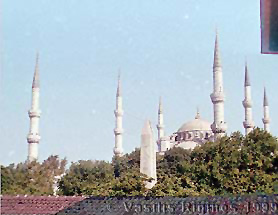
We visited Ayia Sophia together, and then the Blue Mosque, and the nearby Islamic Museum. Then Andonis and I left them to rest at the hotel while we went back to the marina. Our laundry was ready, sort of. They had washed and ironed for 27 million TL everything but our underpants. Never understood why. Andonis packed a bag and left. He was going to take a break from the boat and spend the night at the hotel. I washed my underpants by hand and hung them to dry. I then removed the tent, took a shower, filled the water tanks and went back to the hotel to join the rest of the crew.
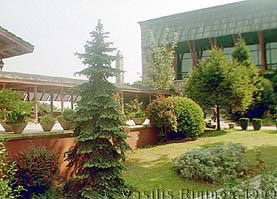
Andonis was determined to try again our luck at the Darüzziyafe the traditional Turkish restaurant near the Süleymaniye Cami (Mosque) that three weeks ago we had such a difficult time finding and, when we found it after a long quest it was all booked by a wedding. This time we asked the hotel to make us a reservation as we were not going to look for it on foot. We were going to take a taxi. We did so, but the taxi was heading in the wrong direction. Andonis got all agitated and involved himself with an argument with the driver. As a result the taxi stopped and we got off. We found another taxi. This one too headed away in the same direction as the previous one. Andonis got rather belligerent, to the point that he would not even listen to the driver’s explanation that he could not take a direct route because of the one-way streets. After a long run-around we did arrive at the restaurant. I cannot be sure whether the driver was right or he took us for a ride and Andonis’ nastiness was justified. The restaurant does not serve any alcoholic drinks but its food was divine. Many wonderful appetizers, meat and vegetarian, wonderful main dishes and deserts. All to the accompaniment of live traditional Turkish music. The total bill for the four of us was a most reasonable 28 million TL. When we finished, the restaurant called two taxis for us: one for the hotel and one to take me back to the marina.
Sunday August 15, 1999, Day 33
This, our last day in Istanbul, was a very busy one. I started it by doing some chores around the boat to prepare her for the new crew. I also took the zodiac out of the water and washed it on the pier with soap and fresh water.
Before we separated last night, we had made the following plan: Although none of us is particularly very religious, we thought that it might be a unique opportunity to attend an Orthodox Sunday mass at the Patriarchate, presided by the Patriarch himself. I had met the Patriarch, a fellow sailor, last year and I too was very keen on the idea of attending a Byzantine service. The arrangement then was for Jane, Corinna, and Andonis to go directly to the Patriarchate and for me to join them there around 10:00. Following the mass we were then going to visit the near by Chora Church, now a museum, which has some very well preserved Byzantine mosaics.

So, after finishing the various boat chores and following this plan, I took the ferry boat and then a taxi to take me to the Patriarchate at the old Faner (Φανάρι). I had borrowed Andonis’ city map on which, I have to admit, the Patriarchate was not very well indicated. Nevertheless, I assumed that the driver would know it. He drove towards that general direction along the Golden Horn and then he started climbing up the steep narrow streets of the Faner. The streets were getting steeper and narrower. Finally the car could go no more. He stopped and pointed to me a large reddish building. I got off and walked up the hill toward this building until I reached a tall fence. It was a dead end. It was hot and very humid. By a circuitous route, up and down streets, steps, and alleys I walked around the fence, to the building’s gate but it was locked. It did not look as if this was the Patriarchate; there was no church. I later found out that it is a closed down Greek school built around the turn of the century. I asked some people if they knew the way to the Patriarchate. They pointed in a direction downhill. I went down hill but no luck. I asked some other people but they did not seem to know. To make the long and tiresome story short, I walked for about an hour but did not find it.
I decided to go on to the Chora Church where surely the rest of the group had to be by know. Again I had difficulty finding my way because most streets, even large ones, have no name signs. I asked more directions. A young man offered to show me the way. We walked together for a long time. He then pointed a direction to me and he went away. I walked some more. When at last, I crossed a marked street, I then realized that the young man had misled me to a totally different region. Eventually I found the Stadium which according to my map should be very close to Chora. Again people did not know its whereabouts although it was no more than a few blocks away. By the time I found it I was totally dehydrated and exhausted.
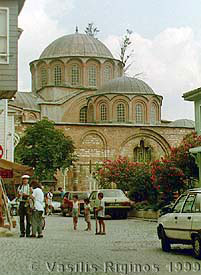
To my great delight, right next to the church/museum was a shaded outdoor café with tables under the trees. The temptation was too much, I had to have a cold drink. As I was climbing the stairs to the café, in the corner of my eye I saw two very familiar figures sipping cold drinks: they were Corinna and Jane. They had already been in the Patriarchate, heard the mass, and were even given a slice each of holy bread (Χριστόψωμο). While Andonis stayed there to wait for me, should I come, they took a taxi to Chora and had already seen the mosaics. Now, there were finishing their drinks and were ready to go back to their hotel for a rest and then go on for more sight seeing. They particularly wanted to see the Topkapi. Now, I had to be back at the marina before 1:00 PM for the interview.
I went inside the church and looked at the mosaics. They were magnificent although some were faded and others were defaced, but they were very definitely worth the hardship I had endured in getting there.
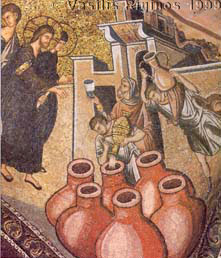
The Miracle of Cana |

The Blind men |
I then took a taxi to Eminonu (the ferry dock), and from there back to Kalamis by the usual ferryboat-dolmus route. Andonis was already there. He was not going to, under any circumstances, miss the interview. The time was 12:50, just 10 minutes before our appointment. He was understandably agitated since he did not know what had happened to me.
Soon, Madame Zuhal Atasoy, editor of the Turkish edition of the Yachting World Magazine, arrived. She was accompanied by Osman Ugur, her photographer. We sat under the tent in the cockpit and introduced ourselves. She is a very charming lady. After the introductions, she produced a small tape recorder and the interview began. She was very interested in my Internet Thetis web site. She wanted to know all the mechanics, costs, why was I doing it, and so on. Then she focused on sailing. How long have I been sailing, how long have I had Thetis, when and how do I singlehandle? Where had we gone on this trip? How did we find the Black Sea? Did we meet many people there? Have we had any problems because of our Greek flag? How many times have I been in Turkey before? How did I meet our mutual friend Turgut? Then it was Osman’s turn. He wanted me to pose with all 3 eastern Mediterranean flags: Italian, Greek, and Turkish. Then he wanted me to work on the computer at the chart table, handle ropes, wear my hat, I lost track. An hour or so later, the interview was over. Now we could be social again. I made coffee for everyone and passed around the Turkish delights that we had bought yesterday at the Grand Bazaar. On hearing that we may be stopping in Imvros, Zuhal told us to look for her Greek friend Panos, who also has a sailboat and was planning to sail to Imvros from Athens.
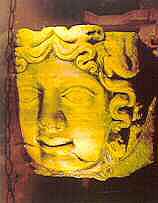
After Zuhal and Osman left, we too left the marina and went back to the Sultan Ahmet district (the area around Ayia Sophia). The ladies were not back at the hotel yet, so Andonis and I went across the street and visited the Yerebatan Saray, the Underground Palace. This cistern (it is not really a palace), as the name says, is deep underground. It was built by the Byzantine emperor Justinian. There is a colossal Medusa head partly submerged in water. During the Ottoman era, the palace was used by the janissaries. It is very interesting in its uniqueness.

Later, we met Jane and Corinna at the hotel. We settled our bills and we all took a taxi to Eminonu, where we introduced them to the ferry boat. At Kadaköy we took another taxi to Kalamis because we were carrying all their luggage. After they dropped their luggage on Thetis we all walked to the new supermarket for a serious shopping of provisions. When all the provisions were stowed and everyone had showers, we all walked to the marina restaurant for our last Istanbul supper. The food was very good and so was the wine.
I paid the marina bill, and then Andonis and I topped the water tanks, disconnected the hose and stowed it in the sail locker. We were almost ready for an early morning departure.
Monday August 16, 1999, Day 34
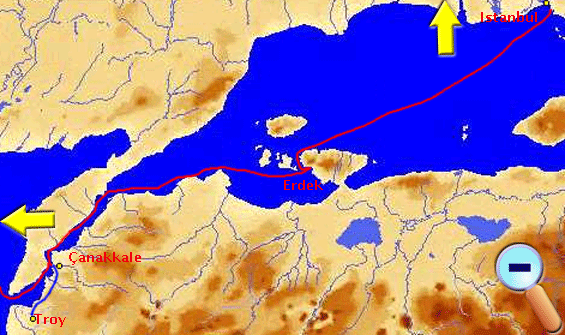
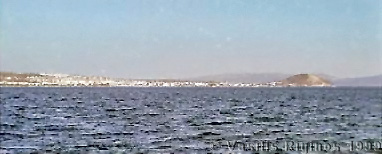
The alarm woke me up at 5:00. We had a long passage ahead of us, and we did want to be in Erdek before it got dark. We started preparing for departure. I disconnected the AC power line and stowed it, we raised the zodiac and lashed in on the deck, etc. We departed Kalamis at 0620. The knotmeter was not working again, its impeller must have been fouled by weed accumulated in these polluted waters over the last three days that Thetis had been idle. After we were clear of the harbor, I removed the impeller and cleaned it. It then worked again.
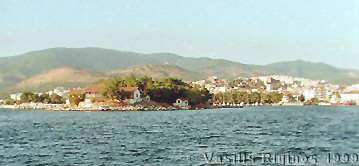
There was no wind and we had to motor. While motoring, I ran the watermaker to prevent it from getting fouled with algae. By 1600 as we were rounding Cape Kapidag (Bear Mountain), a lone playful dolphin approached us and stayed with us for a while. The wind picked up a bit and we were able to open some genoa and sail for a while, while keeping the tent to protect the new crew who had not had a lot of sun exposure yet. Thus we practically entered the harbor of Erdek (the Greek Artaki) [40° 23.6' N 27° 47.4' E] under sail. The time was 1940 and we had done 78.9 M.
The little harbor was crowded. It was hosting for the night the 19 sailing yachts that were participating in the Mayra round of the Sea of Marmara Rally organized every summer by the Ataköy Marina in Istanbul. There simply was no room for us to dock. As we were thinking that we would have to anchor off-shore, the crew of the large Turkish ketch Aheste were waving to us that we could tie on a second tier between them and the British yacht Water Joke. We anchored and came stern-to between the two yachts, their crews catching our stern lines. They all said that we were welcome to walk on their decks when we were to go ashore. Now, that we had a crew of four, one of whom was Corinna who is very experienced, maneuvering was a cinch.
As soon as we were tied down the people from Aheste invited us aboard for a drink. After we freshened up we joined them, bringing with us a bottle of ouzo which was very well received. She had a professional crew of three plus the owner, professor Erol Eti, who in addition to being a noted artist and interior designer, was also teaching at the Marmara University of Fine Arts, and his friend who worked at the US consulate. Everyone had been teasing him that he was actually a CIA agent. They were very agreeable people. One of them said that he had seen Thetis while we were anchored in Poyraz. We certainly had not seen any sailing boats there but again we were both asleep during most of our stay. The crew of Water Joke also joined the party on Aheste. The skipper-owner was Turkish and his crew was Mark, a teenage British boy, son of a friend, who lived in Istanbul. The rest of the Water Joke crew consisted of a Siamese cat and a dog. It was a rather jolly crowd. Professor Eti told us that we were not alone in disapproving of the reconstruction work at the Sumela Monastery; practically all of the architects and archaeologists in Turkey have been protesting about this crude reconstruction. In this case it seems that the politicians in their wish to create welfare work had won, putting aside all the artistic and historical considerations. Eventually the party had to break up because all of the Mayra crews had to go to a reception hosted by the mayor of Erdek. They kindly asked us to join them but we declined as we were tired and hungry.
We went ashore, strolling in this pleasant resort town, looking for a place to eat. After reviewing the offerings, Andonis chose a simple place where we made dinner out of an assortment of pide (a Turkish pizza), lanchmachun (also like a thin crust pizza), kefte kebabs (kebab made of minced meat), and kokoreç (a kebab made with entrails wrapped with intestines, the Greek κοκορέτσι). After dinner, we went back aboard Thetis and had fruits in the cockpit.
Tuesday August 17, 1999, Day 35
At about 0330 I was woken up by a sound. When I got out of my berth and looked around, everything seemed in order with Thetis, but I noticed people on the neighboring boats and I assumed that the Mayra crews were just returning from their celebrations, and I went back to sleep. None of the others in Thetis woke up. Some time later I was woken by a the sound of a horn, and a public address system, of course I did not understand the Turkish announcement, and again I assumed that it must have been a Moslem call for prayer. Thus we slept through one of the worst earthquakes to hit this part of the world within recent times.
When I got up at 0530 to prepare for our departure, I noticed unusual activity in all the seaside çay hanis (tea houses). They were full of people and very well lit. Even I, who am exceptionally dense before my morning coffee, thought that something rather abnormal was going on. I asked the people on Aheste who were also up, what was going on. They said that there was a strong earthquake and they have heard that there were some victims but not here in Erdek. People had panicked and spent the rest of the night outdoors. They did not know very much, other than that the telephone lines had all been knocked down. Indeed we too had no GSM signal. The radio did not have any details. There was not much we could do, so we got ready to leave.

We departed from Erdek, at 0630, heading for Çanakkale. We did not have any problems with our departure. The sea was calm and, of course there was no wind. So we motored again. Later there was a light breeze, 8-12 knots ENE, and we sailed for about an hour, with both sails, after which the wind died out again. We rolled in the headsail and motored into the Dardanelles. We moved to the European side, complying with the traffic separation scheme.
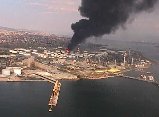
There was absolutely no outbound traffic and the in-bound traffic was almost zero. I checked the GSM phone and, as there was a signal, I sent an e-mail to Alice in Washington D.C. that while there was a strong earthquake in Turkey, we were fine and on our way to Çanakkale. I also called my mother in Athens. She had not even heard the news yet. Later, I received a call from my brother Byron, in Athens. Our mother had by now seen on her TV some early pictures of the fallen buildings and had panicked about our safety. The reports in Athens said that the strength of the earthquake was 7.2 on the Richter scale. By this time we knew that there was serious trouble. Not only was there no shipping traffic, but huge, bellowing, dense smoke clouds were covering the sky to the east. Such clouds could only be caused from extremely large oil fires. Indeed later we learned that the oil refinery in Izmit, the largest in the Middle East, was burning.
We were doing very good time, being pushed by the current. Also, after we entered the straits, there was some feeble wind and we could at least motor-sail. We arrived at Çanakkale [40° 09.3' N 26° 24.3' E] at 1820. Our log indicated 60.9 M over the water, but in fact we had covered 76.7 M over ground. Despite the narrowness of the harbor we picked up the mooring line and docked stern-to without any difficulty. It is wonderful to have my experienced daughter with me.
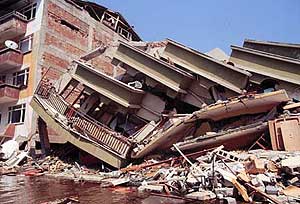
We were welcomed ashore by my old “friend” Sammy whom I had met on our incoming leg. He confirmed that the earthquake was a devastating 7.2 one. There were now reports of collapsed buildings and many victims killed in Izmit and in Istanbul. Also there were many missing people who were believed to be buried under the fallen buildings. All indications were that it was a catastrophe of cataclysmic proportions. We tried to tune to the BBC and the Voice of America but were not able to get them on our AM radio, and we did not have a short-wave one.
We all had hot showers and then assembled in the cockpit and had a drink. However, thoughts of the human tragedy that had occurred right where we had come from had cast a heavy shadow over us. There were two other boats near us. A 46' steel hull with concrete deck flying the Ukrainian flag, with three very uncommunicative men, and the British 36' ketch Thavma with a singlehander. He was very friendly and we chatted for a while. He too had come from the Black Sea, he had been to Bulgaria. He winters his boat in Preveza, Greece. He has had some engine trouble and had been stranded here for a week waiting first for parts and then for repairs.
We walked along the waterfront and sat in a little restaurant just across from the ferryboat terminal. It seems that the rest of the crew were having stomach trouble. Corinna, as matter of fact, just sat with us and did not eat anything. The rest of us ate some fish but I was the only one with any appetite. When we got back on Thetis our neighboring Ukrainian sailboat had being boarded by armed customs officials who were conducting a thorough search of her. Corinna boiled some rice for herself.
Wednesday August 18, 1999, Day 36
I woke up at 7:00 and very soon I was joined in the cockpit by the rest of the crew. We had already arranged with “Sammy,” Aydogan Enginer, to come at 8:30 and take us to Troy (Truva). While waiting for him, we filled the tanks with fresh water and hosed the deck. Aydogan did come and after we got into his car he treated us to a high speed, hair-raising ride to Troy. He tried to give us a running commentary on the history of the site, but in fact he was not very knowledgeable and got several of his facts mixed up. Jane was not feeling very well and neither were Corinna and Andonis. We theorized that they had been affected by the meal at Erdek, but I felt fine. Maybe there was a virus around and it infected me first at Amasra, and now it infected them also.
We had returned back to Thetis by 11:00. Now our first order of business was to go through with the formalities of clearing out of Turkey. Aydogan said that he was very familiar with all of these and he would help us. So Andonis and I followed him first to the Harbor Master’s Office. There we, as well as all the people in the office, were confronted with the first TV broadcasts from the earthquake. There were images of fires, collapsed buildings, and rescues of wounded victims. Bodies and devastation were everywhere. These early reports estimated the dead to be over 4,000. Little did we know that these figures would reach closer to 40,000.
The Harbor Master looked at our transit log and said that the stamps that we already had from Istanbul were sufficient and we did not need his anymore. He directed us to proceed to the Passport Control Office.
The Passport Control Office was at the police station, some distance from the Harbor Master’s Office. Aydogan took us there. At the passport office were also the Ukrainian crew. It seems that they had sailed from Odessa directly to Çanakkale without having cleared into Turkey. The office staff was in a state of great confusion. All the data lines to Istanbul had been knocked down by the earthquake. As a result, they could not access the passport data base and thus be able to stamp any passports either in or out of the country. Aydogan was dispatched by the officials to a nearby store to make photocopies of our passports so that they may be able to fax them for clearance to Istanbul. He extracted 3 million TL ($3.75) from me for this. When he came back, it turned out that the telephone lines were down also and the faxes could not be sent. After spending an hour in the hot and fairly crowded office with the Ukrainians we were told to go away and be back by 1:00 PM when the “director” would be back. Maybe He could authorize the stamping of our passports without the approval of the central database in Istanbul. We certainly appreciated that this was an extraordinary situation beyond the policemen’s control but I could not help myself but wonder how in the world had these bureaucrats managed just a few years ago without the use of computerized databases?
Andonis and I did some provision shopping, mostly fruits, took them back to Thetis, and informed Corinna and Jane of the situation. By 1:00 we were back at the police station where we waited. It was a long and very hot wait, punctuated by the sound of a compressed-air drill that was used to demolish a wall in a nearby office. No more news from the “director.” We were offered tea. Two more hours went by, during which our only entertainment (I should have brought a book with me) was to look at a very pretty policewoman, armed and in uniform, who was giving us severe looks. Then suddenly the exciting news arrived. In another office they had managed to get a telephone voice-line through to Istanbul. With the help of Aydogan, every single line in our and the Ukrainians’ passports was read and transmitted verbally to Istanbul. The telephone line was kept open until it was ascertained that at least the crew of Thetis were not villains. After which our transit-log and our passports were duly stamped. We shook hands all around, including the policewoman who now actually smiled at us, and followed Aydogan to the Customs and Customs Patrol Offices which, although they were at another part of the town, were at least adjacent to each other. The stamping procedure in both of these offices was brief and efficient.
In the marina, we got 54 L of fuel and by 3:10 PM were ready to leave. We paid our bill at the marina office and asked Aydogan what he wanted for his services. True, he had been with us since 8:30, he had driven us to Troy and back, and he had been very helpful with the formalities. But the 150 million TL that he asked, together with the other 3 that I had given him before amounted to $190 which seemed rather excessive. We should not have retained his services before first asking him how much they would cost.
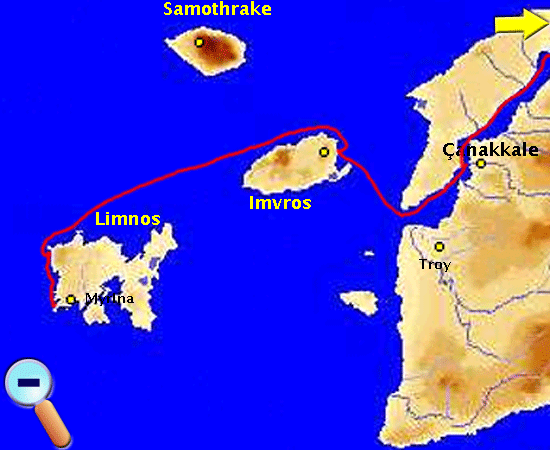
At 1520 we cast off and left Çanakkale for the island Imvros (Gökçeada or Imroz Adasi). Strictly speaking, us going to Imvros after clearing out of Turkey was not legal. On the other hand Imvros is not a port of entry and the only way to visit it legally would be to first go there and then return back to Çanakkale for the clearance. Now, I figured that since we had with us the canceled transit-log and the stamped passports even if the local authorities questioned us we could prove that we had been legally in Turkey and thus talk our way out.
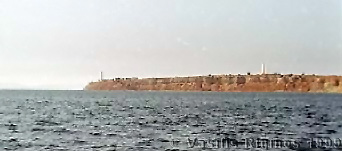
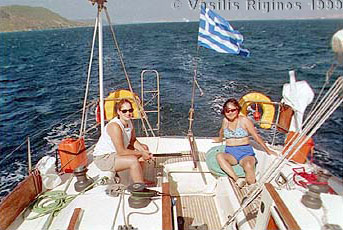
In the Dardanelles, there was a wind of 10-20 knots, NNE with strong gusts. This made sailing possible but as we exited the straits the wind diminished and we had to motor-sail. While we were within the straits the strong current was pushing us and we were averaging better than 9 knots over the ground. When we exited the Dardanelles, we had a little head wind but it was manageable. We continued motor-sailing until we reached the main harbor of Imvros (Ίμβρος) [40° 13.6' N 25° 57.5' E] at 1940. We had come 28.5 M from Çanakkale.
As we were about to dock side-to at the quay, a local small caïque named Gorgona approached us. Inside were two bearded gentlemen who welcomed us to Imvros, in Greek. They told us not to dock where we were heading because it would be too close to the ferryboat due to arrive soon. They said that the best place would be in the inside of the quay but since there was no room there, the end of the quay would be the next best. With Corinna at the helm and Andonis and I handling the lines we docked side-to at the end of the quay in no time.
While we were putting the spring lines, the crew from the Gorgona had already disembarked and came to meet us. Both were wearing blue-jeans. One of the gentlemen introduced himself. He was Chrysostomos the Bishop of Myra (now called Demre) and after staring at me for a while he asked if I was the brother of captain Nikos who owns the Faneromeni! This incredible coincidence had an explanation. Last year, during the Faneromeni’s return trip from the Black Sea, they had stopped here at Imvros and Nikos had met the bishop who, although he lived in Istanbul and was a member of the Patriarch’s staff, he, like the Patriarch, was born on Imvros where he spends his vacation pursuing his hobby: going fishing with his caïque, the Gorgona. Nikos was very impressed with the needs of the Greek community here and the restoration work done by the Patriarchate and wanted to send them a contribution. Because he did not have a checking account in dollars he asked me if I could write him a check. He then mailed it to his friend the Bishop in Istanbul mentioning in his letter that his brother with his sailboat may stop in late August at Imvros. The number of yachts stopping here, especially ones with the Greek flag, is rather limited so when the Bishop saw us he jumped to the right conclusion. Bishop Chrysostomos made profuse apologies that he would not be able to invite us for dinner because tomorrow there was a large church-related fiesta (πανηγύρι - panigyri) and he had to spend some time with the organizing ladies’ committee. But, he would make arrangements for “Hassan” the “very honest” taxi driver to come and take us to see some of the Greek villages and finally to a Greek taverna where he, the Bishop, would later join us.
In the harbor, amazingly enough, there was another Greek sailboat, Amalia II. This was the first Greek boat we had met since leaving Greece. We wondered if that was Panos, that Zuhal, our journalist friend had mentioned, but there was no one aboard. While waiting for Hassan’s taxi we took showers and changed clothes. In the mean-time, the ferryboat from Çanakkale had come and was discharging cars. There was a lot of activity and several taxis had come picking up ferryboat passengers. We were not quite sure how we were to recognize Hassan’s taxi. While we were debating this, a taxi arrived and parked aside from the ferry traffic. We walked over and asked if he was Hassan. He was, but this was as far as our communications went. He only spoke Turkish.
We all got into the taxi and Hassan drove off. We had no idea where we were heading but we hoped the Bishop had told him. First we drove through the main town of Gökçeada, a nasty looking collection of new, but already rundown concrete block buildings. Then the car took a left turn and we started climbing up a dirt road. We reached a village. By this time it was already dark. There was a small café (καφενείο) and facing it on a porch were seated at least 15 people all in a row. All of them were over 65 in age and all spoke Greek. After we introduced ourselves, a “young” couple offered to show us around the village. They explained to us that they, like most of the people in the village, were Greek but during the pogroms in the 60s they, with many others, had left their village and migrated to safety in Greece. Now, and for the past 10 years, they come back for vacation during the summer. Most of the houses, abandoned by their fleeing owners in the 60s, had ran down to the point of being uninhabitable. These houses were then bought by wealthy Turks from Istanbul and were restored as vacation homes. The relations now between the new upscale Turkish owners and the remaining Greek villagers are excellent. They wished that they could say the same for the official government policy. This policy is designed to actively discourage the Greek minority from continuing to live here. This is manifested in this village in both small and large things. For example, the school building was funded entirely by private funds, collected by the Greek community, and it was built on private land donated for the purpose. After the building was completed, the government confiscated it. It has never been used as a school. It is empty, unused, and deteriorating. They and all the other people who have contributed are understandably very bitter. Another example of this policy are the inheritance laws. These are special and apply only to minorities. They make it very hard, with punitive taxation, for children to inherit their parent’s property. This village they proudly told us is the birthplace of the current Patriarch Bartholomew.
We got back into the taxi and Hassan drove us, at high speed, up and down hills, and through many dirt roads until we finally arrived in another high village. The Turkish name of the village is Tapeköy and its Greek name is Agridia (Αγρίδια). We were shown to The Restaurant Barba Yiorgis. It was run by a pleasant young Greek man, and it was small but nice and clean. A loud speaker was piping contemporary Greek music, a little too loudly for my taste. We had a tasty assortment of mezedes (appetizers) and grilled meat. The wine was of their own make and it was very good. The proprietor came and sat with us. She is Greek but from the island of Tenedos. Her husband, a retired professional, is from this village. After his retirement, they came back here and opened the restaurant “because it was needed.” Around this time, our friend the Bishop came. He was dressed in a black business suit made of light fabric. He was accompanied by another similarly dressed bearded gentleman who was introduced as the Bishop of Imvros. They sat down and we had a conversation during which the bishops re-confirmed the story we had heard about the discriminatory inheritance laws.
Our Bishop said that he had a book that he would like to give me to take back to Nikos. Would we mind if we went with him to his nearby office to get it? No, of course we did not mind. It turned out, however, that he did not have his keys with him. A young woman was immediately dispatched to go and fetch the keys. While waiting for the keys, two ladies arrived on foot and asked the Bishop if he could provide them with transportation tomorrow to the panigyri (fiesta). He answered that his caïque was full as she would be transporting 17 people, all the other caïques were also booked. Sorry, but they would have to walk. We never quite ascertained where this panigyri was going to be. All the island location names shown on maps are in Turkish but all these people were using their original Greek names, which to us were impossible to locate.
After the keys arrived, we walked, following the Bishop to a new building which, he explained, has been built to house a museum and a youth center. Indeed, inside there were some meager exhibits and a large room with a projection screen and a bar. He gave us the book for Nikos, after writing a dedication, and another book for me. The book is a dissertation on the island and its ecclesiastical history. In a corner of his office was a cardboard box full of T-shirts imprinted with a map of the island and the name “Agridia” written in Greek. He explained that they were for sale and should we wished he would be glad to sell them to us. All the proceeds are in support of the local Greek community, especially the youths who are having a particularly difficult time growing up in this officially hostile environment. Of course, we bought some shirts from the Bishop.
Thursday August 19, 1999, Day 37
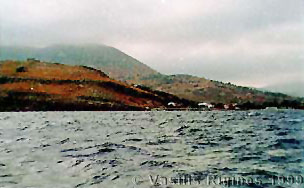
By the time we returned to the harbor, it was past midnight. We had hardly stepped on board Thetis when we were called, in Greek. The voice came from the Greek sailboat Amalia II, which was rafted alongside a small motor cruiser. We went over and met her owner. He was indeed “Panos,” or more correctly Panayiotis, that Zuhal, our journalist friend had mentioned. He had singlehandled her here from Athens. He was sitting in his cockpit together with another gentleman whom he introduced to us as the Harbor Master. There was no escape, we had to join them. The Harbor Master owns a trained lamb with which he strolls around the island. When he walks, the lamb follows behind him. He also owns a black kitten which follows the lamb. At this late hour, the lamb was asleep and we did not meet it. But we did meet the kitten which was resting on the boom of Amalia II. Panayiotis offered us some excellent but very strong tsikoudia (a Cretan drink similar to ouzo and raki) which he had acquired from Sitia. Panayiotis was born in Imvros but he has been living many years now in Athens. He is an avid sailor, and brings his boat to Imvros almost every summer. He was now on his way to Istanbul. He keeps his boat at the Olympic Marine in Lavrio, where Thetis is serviced every year, and we also have a number of mutual acquaintances. We talked about the earthquake. They had experienced here a substantial tidal wave, they estimated it as 2 m high. He kept re-filling our glasses to the brim. In the meantime, the Harbor Master left us for a short period. When he returned he had brought a basket full of delicious figs from his garden. This called for another drink with toasts all around. We toasted to Panayiotis’ trip, to our trip, to the lamb, to the Harbor Master, to better Turkish-Greek relations, to the island of Imvros, to the kitten, and so on. By the time we staggered back on Thetis it was 02:30. I just collapsed into a deep stupor.
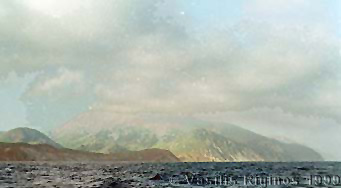
Before I knew it the alarm was ringing. It was time to get ready for our long passage to Limnos. We departed from Imvros at 0630. Our departure was without any difficulties. There was a strong NNE breeze. We sailed along the N side of the island for a while with the genoa and the main sail in the 1st reef. But as soon as we changed to a more southern course, after reaching the end of the island, we were going almost completely down wind and we had to roll-in the headsail. Our down wind sail was a fast one, around 9 knots over ground. As we were approaching the NW corner of Limnos the wind decreased so much that we had to turn on the motor. We anchored just under Cape Mourzeflos, on its south side, [39° 58.9' N 25° 02.6' E] at 1440, having covered 46.6 ground M (37.6 M over water).
The water here was incredibly clear. We all jumped in. I had not seen such waters since Tenedos almost a month ago. Our eyes were feasting in its blue and translucent emerald colors. You really have to be away from the Aegean to truly appreciate how special it is. We had some lunch and took it easy under the tent. At 1630, we raised our anchor and motored for 6 M to the main harbor of Myrina.
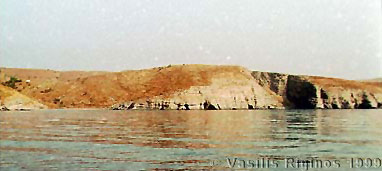
We arrived at Myrina [39° 52.3' N 25° 03.3' E] at 1745. Most of the berths designated for visiting yachts were occupied by several large inflatables. We decided that if we wanted to avoid the spot of the Ayios Efstratios ferryboat which comes every morning (I remembered this from last year) we had to go next to a large motor cruiser. We anchored and while Corinna was backing the boat I got ready to jump ashore to tie our stern lines. It was not necessary, a man came and tied them for us. It turns out that he was crew to the cruiser and since he wanted us not to touch their cruiser he tied us in a way that we would interfere with the ferry. We later had to redo the lines. While washing up, prior to reporting to the authorities, a man came and introduced himself. He was in charge of water and electricity. In no time we were connected.
Corinna and I took all our passports and ship’s documents and went to the Harbor Master’s Office (Limenarchio) a few steps away. Amazingly it was air-conditioned. I do not think that I have ever been to an air-conditioned Greek public office before. This was good, since there was no breeze and it was very hot outside. The officer behind the counter was very polite. He told us to fill out a simple form and asked for a crew list. He told us to go back on board and wait for the Customs Officer, whom he just called, to come and complete our check-in to Greece. As far as he was concerned we were done with his agency. It is hard to believe that this Limenarchio and the one in Mitilini not only belong to the same country but are part of the same service!
We went back on Thetis and waited, and then waited some more. No sign of the Custom’s man. After 1½ hour I hailed the Limenarchio on the VHF channel 12. They promised to look into it and call us back, which they did and told us that the man would be with us shortly. I was just turning the VHF off when he arrived on a motor-scooter. He took our passports and said that he would be returning them within an hour and “of course, we were free to go ashore.” The hour passed and the man had not returned. It was now 9:00 PM and we were hungry and tired. We wanted to go out and eat but we did not dare leave the boat lest we miss the man with our passports. Andonis and I walked to the Limenarchio to inquire. The Customs Office, we were told, was closed for the day. After our insistence and some confusion the man spoke to his colleagues. It turns out, the Customs’ man did return our passports but instead of bringing them to Thetis as we had understood, he had left them at the Limenarchio. This was the end of the arrival formalities. Other than the wait, it was fairly painless. They gave us all of the passports except mine. This was to make sure that, before departing, I would come and pay the harbor dues. This is Greece, after all.
We walked to the end of the small inner fishing harbor to the Glaros restaurant and had some boiled shrimps and grilled galeos (sand shark). After dinner, although we were all tired, we took a short walk around the charming town.
The total distance we traveled from Istanbul to Myrina, Limnos was 237 M and 41 travel hours.